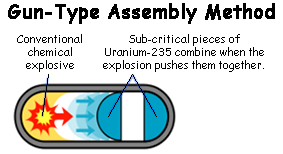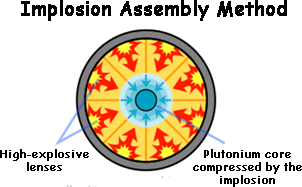Nuclear Weapons A nuclear weapon is an explosive device that derives its destructive force from nuclear reactions, either just using fission (as in the first 'atomic' bombs) or using a combination of fission and fusion - as in 'hydrogen' bombs. Nuclear reactions release vast quantities of energy from relatively small amounts of matter. A critical mass of fissile material is required. The mass of some of the matter is converted into energy. See binding energy. Nuclear weapons require highly enriched nuclear material. This is done in a centrifuge.
Deployment of nuclear weaponsThe only nuclear weapons that have been used in a war were early fission weapons:
Since the bombings of Hiroshima and Nagasaki, nuclear weapons have been detonated on over two thousand occasions but only for testing purposes and demonstrations. It is estimated (in 2012) that there are over 17,000 nuclear warheads in the world, with around 4,300 of them considered ready for use or 'operational'. all of today's nuclear weapons have far more destructive power than the ones used in World War II.
|
Follow me...
|







